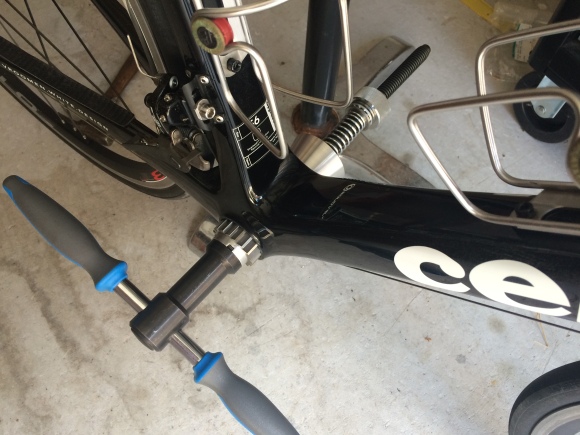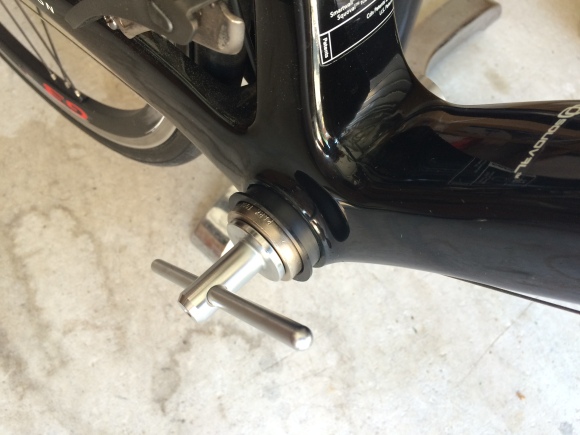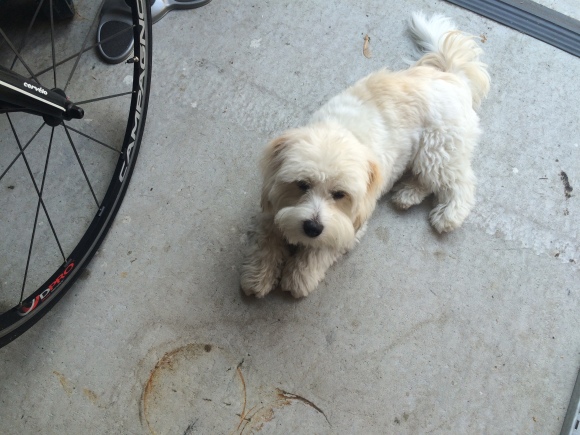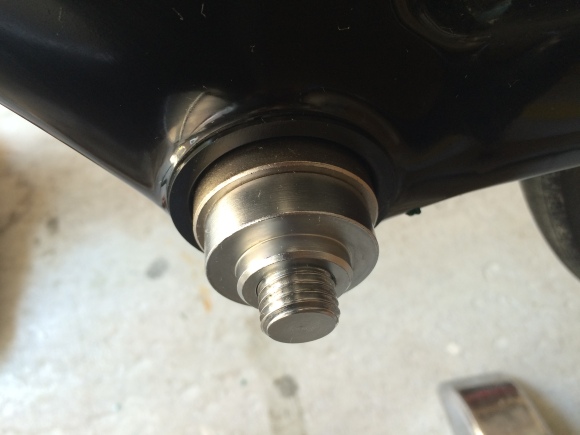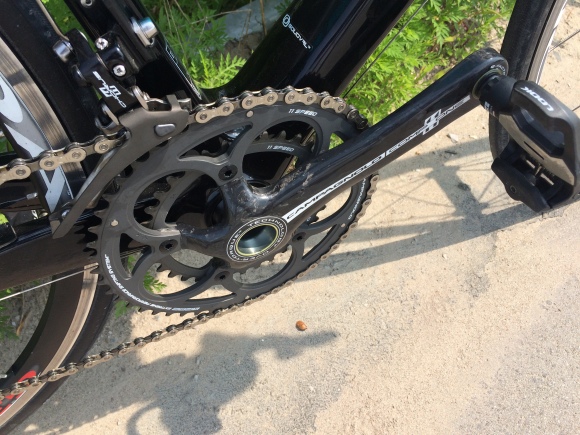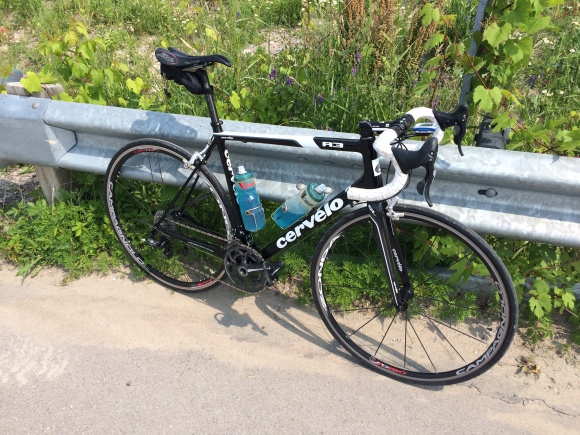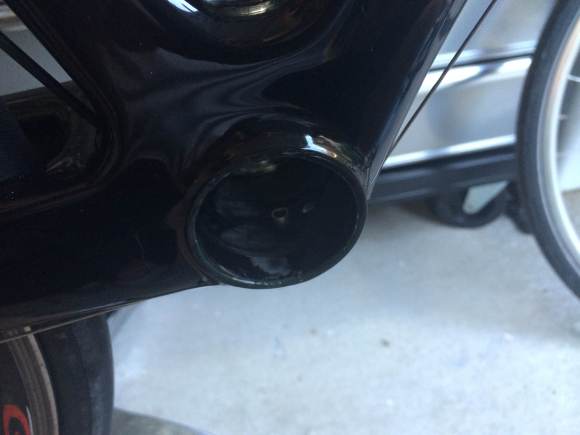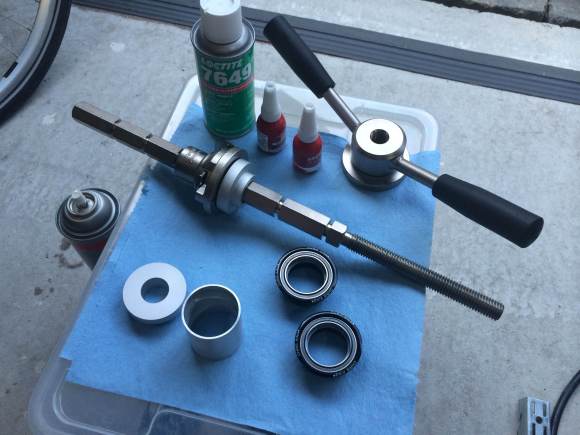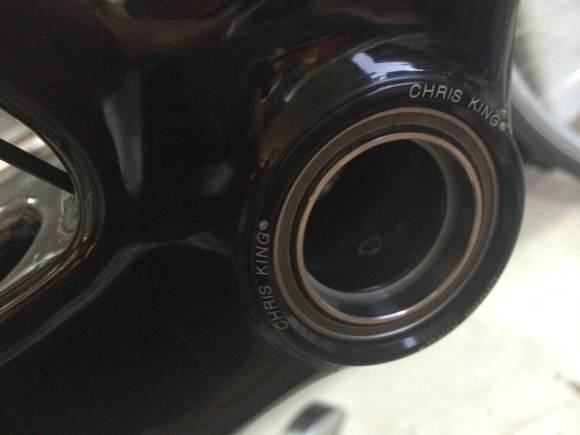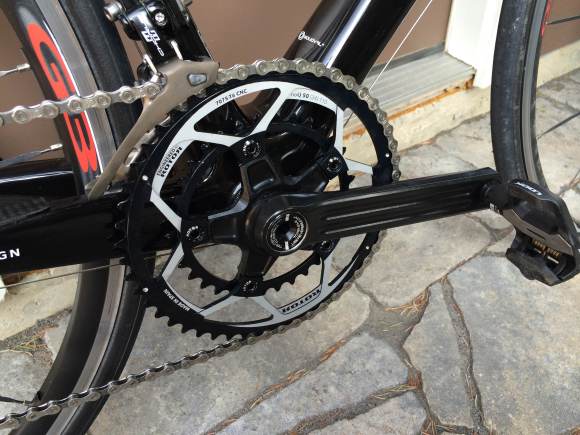Finally, finished the Cinelli build. A few issues required some last minute ordering and running around.
The front derailleur requires a clamp-on type. The clamp to braze on derailleur adapter that was shipped with the bike was giving me issues with tire clearance, as the clamp was rotated to the rear of the seat tube, a rather odd design. Notice the clamp in the picture below. When the clamp is rotated to properly orient the tab that the derailleur mounts to, the portion where the screw fixes the clamp together ends up only a few mm from the rear tire.

A few phone calls and I managed to source a 35mm Campagnolo adapter from LaBicicletta here in Toronto. I also picked up a Campagnolo Chain Security Device FD-SR103. It’s a brilliant design that allows you to adjust the front derailleur and chain catcher position independently. Unfortunately, it’s not compatible with a clamp-on derailleur (or in my case, a braze on derailleur fixed to a clamp). I’ll save it for the Cervelo re-build coming up.
Fizik Bar Gel. I have been using bar gel under my tape for 5 years now. I can’t live without it as I like the extra thickness it adds to the bar and the gooey comfort it provides. When I unwrapped the bar tape from the Cervelo to scavenge the Chorus shifters, the gel had essentially fused to the bar requiring me to cut/scrape it off. Luckily another trip to LaBicicletta saved me.
The rest of the build went smoothly. Cranks went on without a hitch. I did a deep cleaning of the shifters, pulling off the hoods and cleaning the copious amounts of greasy crud that accumulated inside them, thank you WD-40.
The only stupid thing I did was put a kink in the rear derailleur cable, right where the cable sits in the housing as it enters the derailleur. I ordered a 10 pack of replacement cables and will replace it as soon as they arrive, as downshifting is suffering as a result.

And there we have it, fini. Bottle cages are Elite Ciussi Inox, again scavenged from the Cervelo, as are the Look Keo 2 Max Carbon pedals. I have replacements on order. The Selle SMP Pro I pulled off my CycleOps trainer.
So how does it ride? Well, I did the inaugural 50 km shakedown this morning to the beach and back, a route that offers a little of everything road wise – some relatively smooth pavement but mostly rough as hell pothole filled Toronto roads and a few light climbs.
Here are my impressions. It’s one hell of a stiff bike at the bottom bracket. Right up there with peloton worthy carbon bikes. The front end is INCREDIBLY stiff, more so than the Cervelo R3. And despite clearance for 28mm tires, it’s no “Fondo” bike. It turns fast very instinctively as if controlled by Jedi mind power. A Crowbar crossed with a Ferarri. This is very much a fast group riding or race orientated machine.
It’s not a lightweight, but I never felt I was slogging my city bike up the hills. The all carbon front end probably contributes to the bikes light feeling and handling. The Sirocco wheels roll fast and are equally stiff, and those Conti Grand Prix Classic tires have made me re-think my “320 TPI, no less” tire snob attitude.

Aluminum frames have a horrid reputation for harshness. But, Aluminum tube sets and alloys have improved since Cannondales 1983 ST500. This is not a harsh riding bike, thanks to the triple butted aluminum tube set. There is definitely compliance in the frame, so I didn’t feel like every imperfection in the road was going straight to my ass and hands.

The big difference between the Cinelli and the carbon Cervelo (and the carbon Look I rode previously) is if you should hit (and around here it’s more like WHEN you hit) a nasty bit of pavement – like a deep crack or hole – THEN you feel the absence of Carbons magic damping quality. I hit a few nasty holes today, and it was a swearing DOUBLE ouch. Ride Paris-Roubaix on this? No thanks. But for most road riding I’ll be doing, it will be just fine.





















 De-greasing the cups with the appropriate Loctite formulation. I spray then give the threads a quick wipe with a clean paper towel then allow the excess to evaporate before applying Loctite 246 to the cups and installing them. Loctite 246 is a medium strength low viscosity thread locker I use on steel, aluminum and titanium frames as a little heat is sometimes necessary to remove the fastener. Not an issue on metal frames. Would not recommend 246 on carbon frames, rather go with 242. Unless you are cool hitting your carbon frame with a heat gun or torch…..
De-greasing the cups with the appropriate Loctite formulation. I spray then give the threads a quick wipe with a clean paper towel then allow the excess to evaporate before applying Loctite 246 to the cups and installing them. Loctite 246 is a medium strength low viscosity thread locker I use on steel, aluminum and titanium frames as a little heat is sometimes necessary to remove the fastener. Not an issue on metal frames. Would not recommend 246 on carbon frames, rather go with 242. Unless you are cool hitting your carbon frame with a heat gun or torch…..


